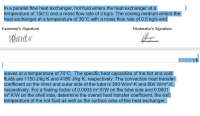
Elements Of Electromagnetics
7th Edition
ISBN: 9780190698614
Author: Sadiku, Matthew N. O.
Publisher: Oxford University Press
expand_more
expand_more
format_list_bulleted
Concept explainers
Question
thumb_up100%

Transcribed Image Text:In a parallel flow heat exchanger, hot fluid enters the heat exchanger at a
temperature of 150°C and a mass flow rate of 3 kg/s. The cooling medium enters the
heat exchanger at a temperature of 30°C with a mass flow rate of 0.5 kg/s and
Examiner's Signature
Moderator's Signature
Page |5
leaves at a temperature of 70°C. The specific heat capacities of the hot and cold
fluids are 1150 J/kg-K and 4180 J/kg-K, respectively. The convection heat transfer
coefficient on the inner and outer side of the tube is 300 W/m?.K and 800 W/m?.K,
respectively. For a fouling factor of 0.0003 m².K/W on the tube side and 0.0001
m?.K/W on the shell side, determine the overall heat transfer coefficient, the exit
temperature of the hot fluid as well as the surface area of the heat exchanger.
Expert Solution
This question has been solved!
Explore an expertly crafted, step-by-step solution for a thorough understanding of key concepts.
This is a popular solution
Trending nowThis is a popular solution!
Step by stepSolved in 3 steps with 3 images

Knowledge Booster
Learn more about
Need a deep-dive on the concept behind this application? Look no further. Learn more about this topic, mechanical-engineering and related others by exploring similar questions and additional content below.Similar questions
- A heat exchanger is being investigated as a waste heat recovery device. A heat exchanger is common device for using a hot fluid to heat a cold fluid without the fluids mixing. The following information is known. The cold fluid stream of liquid A enters at 294.2 K and leaves the device at a temperature of 320.91 K. Liquid A flows at a rate of 0.006 Kg/s and has a specific heat of 4180 J/(Kg K). Liquid B enters the device at a temperature of 350.2 K. Liquid B flows at a rate of 0.005 Kg/s and has a specific heat of 3900 J/(Kg K The dead state is at 293.2 K and 1 bar. The device is adiabatic and the pressure losses are neglected in this problem. Both liquids are incompressible materials. Tout=316.154K Answer the following: If the exiting liquid B is not used for any useful purpose, calculate the exergy destroyed associated with it.arrow_forwardbased on a double-pipe counter flow heat exchanger to be used to cool oil that enters the heat exchanger at 300°F to 105°F at a rate of 5 lbm/s by water that enters at 70°F at a rate of 3 Ibm/s. The diameter of the tube is 1 in. and the length is 20 ft. The measured overall heat transfer coefficient of this heat exchanger is 2.14 Btu/s-ft2-°F. [Oil, c, = 0.525 Btu/lbm°F, Water, c, = 1.0 %3D Btu/lbm°F] The logarithmic mean temperature difference in °C is 46.1 cannot be determined 35.0 59.4arrow_forwardA shell-and-tube heat exchanger is used to cool compressed liquid methanol from 176 °F to 104 °F. The methanol flows on the shell side of the exchanger. The coolant is water that rises in temperature from 50 °F to 86 °F and flows within the tubes at a rate of 68.9 kg s-1. Finding the appropriate thermophysical data and applying the proper equations, you are required to do the following:arrow_forward
arrow_back_ios
arrow_forward_ios
Recommended textbooks for you
 Elements Of ElectromagneticsMechanical EngineeringISBN:9780190698614Author:Sadiku, Matthew N. O.Publisher:Oxford University Press
Elements Of ElectromagneticsMechanical EngineeringISBN:9780190698614Author:Sadiku, Matthew N. O.Publisher:Oxford University Press Mechanics of Materials (10th Edition)Mechanical EngineeringISBN:9780134319650Author:Russell C. HibbelerPublisher:PEARSON
Mechanics of Materials (10th Edition)Mechanical EngineeringISBN:9780134319650Author:Russell C. HibbelerPublisher:PEARSON Thermodynamics: An Engineering ApproachMechanical EngineeringISBN:9781259822674Author:Yunus A. Cengel Dr., Michael A. BolesPublisher:McGraw-Hill Education
Thermodynamics: An Engineering ApproachMechanical EngineeringISBN:9781259822674Author:Yunus A. Cengel Dr., Michael A. BolesPublisher:McGraw-Hill Education Control Systems EngineeringMechanical EngineeringISBN:9781118170519Author:Norman S. NisePublisher:WILEY
Control Systems EngineeringMechanical EngineeringISBN:9781118170519Author:Norman S. NisePublisher:WILEY Mechanics of Materials (MindTap Course List)Mechanical EngineeringISBN:9781337093347Author:Barry J. Goodno, James M. GerePublisher:Cengage Learning
Mechanics of Materials (MindTap Course List)Mechanical EngineeringISBN:9781337093347Author:Barry J. Goodno, James M. GerePublisher:Cengage Learning Engineering Mechanics: StaticsMechanical EngineeringISBN:9781118807330Author:James L. Meriam, L. G. Kraige, J. N. BoltonPublisher:WILEY
Engineering Mechanics: StaticsMechanical EngineeringISBN:9781118807330Author:James L. Meriam, L. G. Kraige, J. N. BoltonPublisher:WILEY

Elements Of Electromagnetics
Mechanical Engineering
ISBN:9780190698614
Author:Sadiku, Matthew N. O.
Publisher:Oxford University Press

Mechanics of Materials (10th Edition)
Mechanical Engineering
ISBN:9780134319650
Author:Russell C. Hibbeler
Publisher:PEARSON

Thermodynamics: An Engineering Approach
Mechanical Engineering
ISBN:9781259822674
Author:Yunus A. Cengel Dr., Michael A. Boles
Publisher:McGraw-Hill Education

Control Systems Engineering
Mechanical Engineering
ISBN:9781118170519
Author:Norman S. Nise
Publisher:WILEY

Mechanics of Materials (MindTap Course List)
Mechanical Engineering
ISBN:9781337093347
Author:Barry J. Goodno, James M. Gere
Publisher:Cengage Learning

Engineering Mechanics: Statics
Mechanical Engineering
ISBN:9781118807330
Author:James L. Meriam, L. G. Kraige, J. N. Bolton
Publisher:WILEY